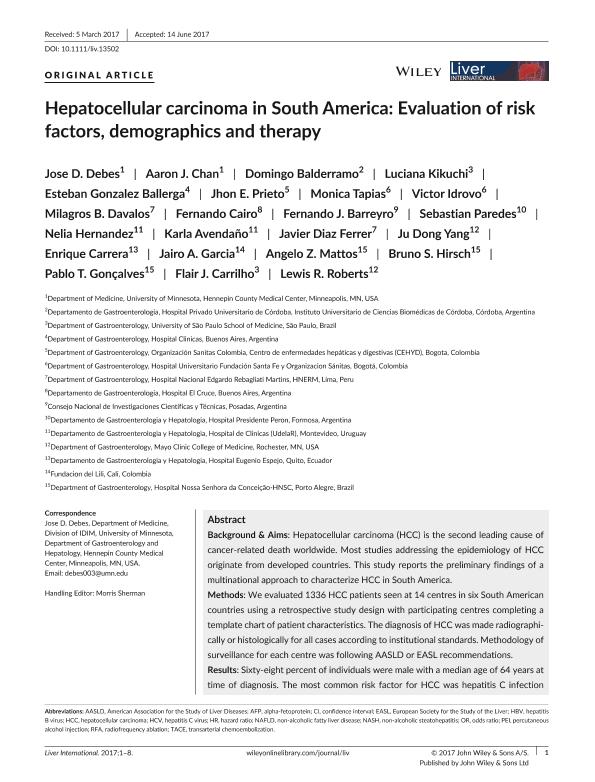Artículo
Hepatocellular carcinoma in South America: Evaluation of risk factors, demographics and therapy
Debes, Jose D.; Chan, Aaron J.; Balderramo, Domingo; Kikuchi, Luciana; Gonzalez Ballerga, Esteban; Prieto, Jhon E.; Tapias, Monica; Idrovo, Victor; Davalos, Milagros B.; Cairo, Fernando; Barreyro, Fernando Javier ; Paredes, Mario Sebastian; Hernandez, Nelia; Avendaño, Karla; Diaz Ferrer, Javier; Yang, Ju Dong; Carrera, Enrique; Garcia, Jairo A.; Mattos, Angelo Z.; Hirsch, Bruno S.; Gonçalves, Pablo T.; Carrilho, Flair J.; Roberts, Lewis R.
; Paredes, Mario Sebastian; Hernandez, Nelia; Avendaño, Karla; Diaz Ferrer, Javier; Yang, Ju Dong; Carrera, Enrique; Garcia, Jairo A.; Mattos, Angelo Z.; Hirsch, Bruno S.; Gonçalves, Pablo T.; Carrilho, Flair J.; Roberts, Lewis R.
 ; Paredes, Mario Sebastian; Hernandez, Nelia; Avendaño, Karla; Diaz Ferrer, Javier; Yang, Ju Dong; Carrera, Enrique; Garcia, Jairo A.; Mattos, Angelo Z.; Hirsch, Bruno S.; Gonçalves, Pablo T.; Carrilho, Flair J.; Roberts, Lewis R.
; Paredes, Mario Sebastian; Hernandez, Nelia; Avendaño, Karla; Diaz Ferrer, Javier; Yang, Ju Dong; Carrera, Enrique; Garcia, Jairo A.; Mattos, Angelo Z.; Hirsch, Bruno S.; Gonçalves, Pablo T.; Carrilho, Flair J.; Roberts, Lewis R.
Fecha de publicación:
06/2017
Editorial:
Wiley Blackwell Publishing, Inc
Revista:
Liver International
ISSN:
1478-3223
Idioma:
Inglés
Tipo de recurso:
Artículo publicado
Clasificación temática:
Resumen
Background & Aims: Hepatocellular carcinoma (HCC) is the second leading cause of cancer-related death worldwide. Most studies addressing the epidemiology of HCC originate from developed countries. This study reports the preliminary findings of a multinational approach to characterize HCC in South America. Methods: We evaluated 1336 HCC patients seen at 14 centres in six South American countries using a retrospective study design with participating centres completing a template chart of patient characteristics. The diagnosis of HCC was made radiographically or histologically for all cases according to institutional standards. Methodology of surveillance for each centre was following AASLD or EASL recommendations. Results: Sixty-eight percent of individuals were male with a median age of 64 years at time of diagnosis. The most common risk factor for HCC was hepatitis C infection (HCV, 48%), followed by alcoholic cirrhosis (22%), Hepatitis B infection (HBV, 14%) and NAFLD (9%). We found that among individuals with HBV-related HCC, 38% were diagnosed before age 50. The most commonly provided therapy was transarterial chemoembolization (35% of HCCs) with few individuals being considered for liver transplant (<20%). Only 47% of HCCs were diagnosed during surveillance, and there was no difference in age of diagnosis between those diagnosed incidentally vs by surveillance. Nonetheless, being diagnosed during surveillance was associated with improved overall survival (P = .01). Conclusions: Our study represents the largest cohort to date reporting characteristics and outcomes of HCC across South America. We found an important number of HCCs diagnosed outside of surveillance programmes, with associated increased mortality in those patients.
Palabras clave:
Demographics
,
Hepatocellular Carcinoma
,
Risk Factors
,
South America
Archivos asociados
Licencia
Identificadores
Colecciones
Articulos(CCT - NORDESTE)
Articulos de CTRO.CIENTIFICO TECNOL.CONICET - NORDESTE
Articulos de CTRO.CIENTIFICO TECNOL.CONICET - NORDESTE
Citación
Debes, Jose D.; Chan, Aaron J.; Balderramo, Domingo; Kikuchi, Luciana; Gonzalez Ballerga, Esteban; et al.; Hepatocellular carcinoma in South America: Evaluation of risk factors, demographics and therapy; Wiley Blackwell Publishing, Inc; Liver International; 38; 1; 6-2017; 136-143
Compartir
Altmétricas



